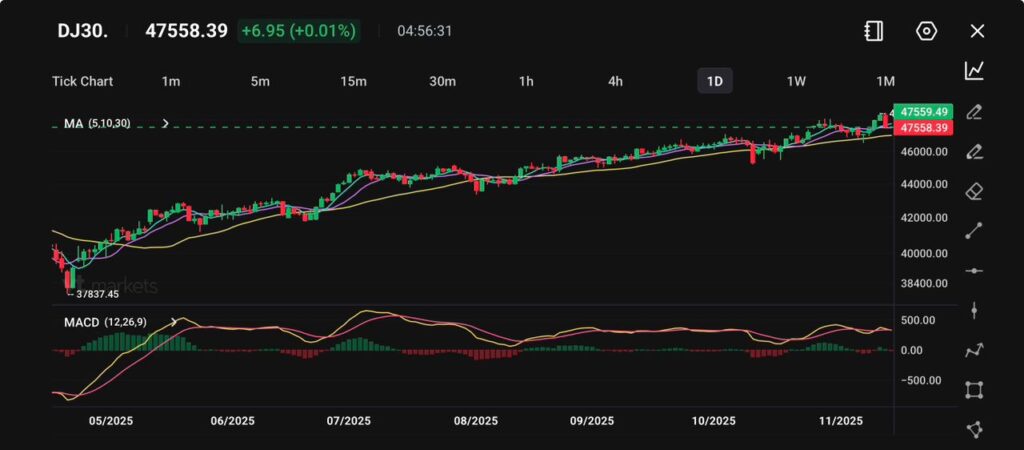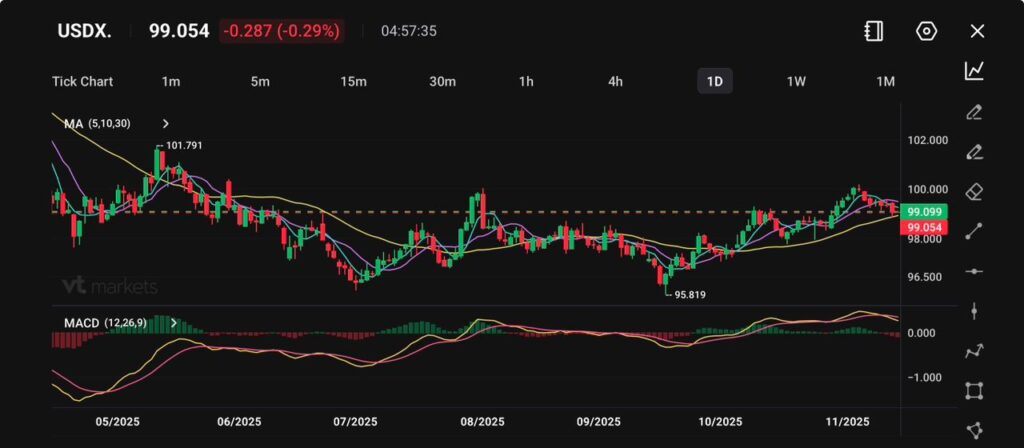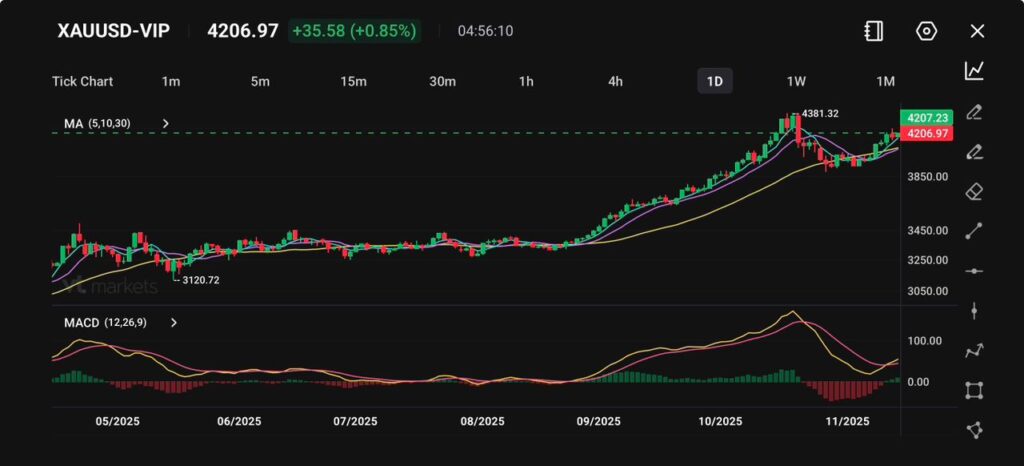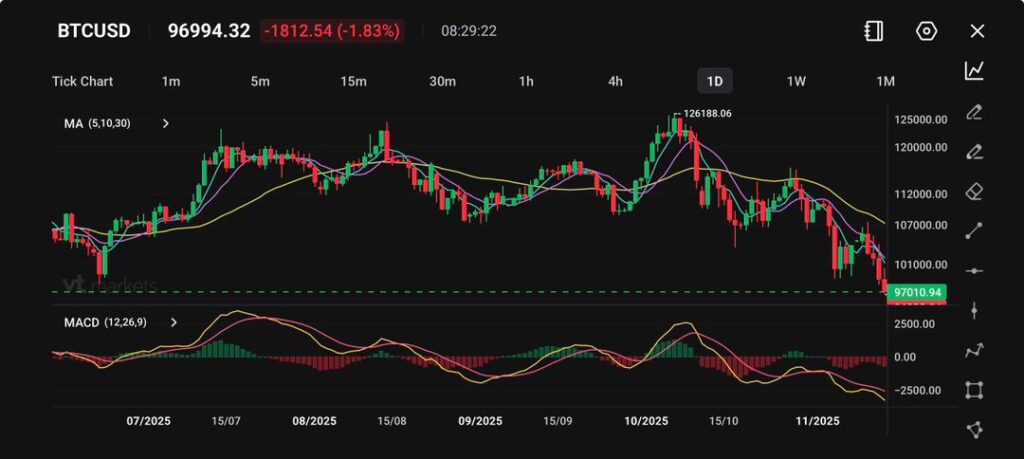
The U.S. government shutdown finally wrapped up. Under normal conditions, this should have been a green light for equities. Instead, the Dow Jones stock markets dipped and safe-haven demand climbed.
Gold rallied during the Asian market session. Treasury yields softened. Traders treated the event not as a relief signal, but as confirmation of a deeper concern: uncertainty did not vanish with the shutdown; it simply shifted shape.
Markets are forward-looking. The shutdown ending removed one obstacle, but it did not remove the underlying weakness in sentiment. Traders care less about the headline ending and more about the path ahead. That path is cloudier than before.
Why Equities Dropped and Safe Havens Jumped
There are three clear reasons behind the counterintuitive move.
- The damage is already done
The weeks of shutdown created gaps in economic reporting, delays in data collection, and a weaker information landscape. Traders do not like operating blind.
When visibility falls, risk appetite drops with it. A post-shutdown bounce becomes harder to sustain when structural uncertainty remains.
- Confidence in rate cuts is fading
Before the shutdown, markets were still entertaining the idea of a possible Fed cut.
After the shutdown, that hope is thinning. With higher inflation pockets still in play and the Fed signalling caution, traders are scaling back their rate cut expectations.
A reduced chance of a cut means tighter financial conditions. Tighter conditions are rarely bullish for the Dow Jones stock market.
- Positioning rotated fast
As soon as it became clear that a rate cut was not imminent, traders moved back into safety. Gold, defensive equities, and bonds all saw renewed interest. Meanwhile, the dollar softened as economic uncertainty weighed on sentiment.
This rotation is a classic response when policy relief looks less likely. Risk assets give way to safe havens, and the Dow takes the hit.
Overnight Recovery: Did the Dow Climb Back?
The Dow Jones stock market closed sharply lower, dropping about 1.7 percent after reaching record highs the previous day.
This selloff reflected a real shift in sentiment, and it also highlighted how sensitive equity traders have become to the changing expectations around interest rates and policy direction.
In the hours after the New York session ended, Dow futures did move higher. The rebound showed that some buyers were willing to step back in once the dust settled.
The recovery was only partial. Based on available data, the Dow did not return to its previous peak above 48,000. The after-hours climb eased some pressure but it did not reverse the full decline.
This is important because a partial bounce often tells a clearer story than a full one. Buyers are present and active, yet they are not committing enough to drive the index back to its highs.
That kind of behaviour usually reflects hesitation about the short-term outlook.
For the Dow Jones stock markets, this pattern of a daytime dip followed by a modest overnight lift suggests that the market is still weighing broader risks.
Until conviction improves, resistance is likely to remain firm and upside momentum may be limited.
Why Traders are Losing Faith in a Fed Cut
Markets have been pricing a gentler Fed for months, but the shutdown has disrupted that narrative. With economic clarity now delayed and some segments still showing sticky pricing pressure, traders are rethinking expectations.
A rate cut is no longer just about inflation. It is now about the credibility of the data pipeline, the strength of labour markets, and the Fed’s appetite for risk.
As long as policymakers avoid making forward commitments, expectations for immediate easing will continue to fall.
For the Dow Jones stock markets, this removes a key tailwind. When the cost of money stays high, the cost of risk stays high too.
Technical Analysis on Key Charts
Here we look at fourmajor instruments: the Dow Jones index (DJ30), the U.S. Dollar Index (USDX), Gold (XAUUSD), and Bitcoin (BTCUSD)
Dow Jones (DJ30)

The Dow Jones stabilised near 47,550 after the shutdown-driven dip. The trend remains bullish, with the moving averages still stacked upward and no structural breakdown in sight.
MACD momentum has softened but remains positive.
The index is holding higher ground, and traders are treating the recent drop as a sentiment-driven shakeout. A clean move above 48,000 would reset bullish momentum, while a drop below 47,000 would risk a deeper correction.
US Dollar Index (USDX)

The dollar index slipped back toward 99.00 after failing to hold above the 100.00 region. The candles show slowing momentum, and the MACD is flattening, which signals that bullish pressure is fading.
The structure still leans upward, but the short-term pullback suggests consolidation rather than continuation. If the index holds above 98.50, buyers remain in control. A stronger decline would ease pressure on risk assets, including the Dow Jones.
Gold (XAUUSD)

Gold continues to attract defensive flows, trading firmly above the 4,200 level with a strong bullish structure. The MACD has turned upward again, confirming renewed buying interest.
Each dip has been defended, and the market still leans toward higher levels as long as price holds above the 4,150 support region.
Persistent strength in gold highlights the cautious tone across markets and signals that traders are not fully rotating back into risk yet.
Bitcoin (BTCUSD)

Bitcoin slipped below $100,000, breaking below the level for the first time in 188 days. The drop came as traders scaled back expectations of a near-term Fed cut after hawkish remarks from policymakers reignited inflation worries.
ETF flows have also turned negative, with nearly 1 billion dollars in outflows over the past nine sessions. With liquidity thinning and momentum fading, the recent bounce driven by institutional optimism has cooled.
The overall trend is still holding, but Bitcoin’s next move will depend on whether fresh institutional demand returns. A steady push back above 100,000 would help rebuild confidence, while staying below it may lead to more consolidation.
Volatility is Back and Traders Need to Adjust
Volatility has returned to the forefront. When policy uncertainty mixes with delayed data and shifting expectations, breakouts and pullbacks become sharper. This is exactly the environment that punishes passive positioning but rewards disciplined setups.
Shorter time frames, tighter stops, cleaner entries, and more selective trade filtering become essential. Market direction is no longer a straight line. It is a rotation cycle.
This is where trading education matters.
Learn from VT Markets
For deeper insights on how to navigate choppy conditions, watch VT Markets Analyst Ross Maxwell’s video series on trading structure, volatility management, and chart discipline. It gives traders the tools to manage the next phase of market movements with confidence.
Check out our Instagram page here.









